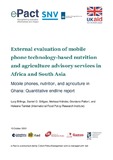| dc.contributor.author | Billings, Lucy | |
| dc.contributor.author | Gilligan, Daniel O. | |
| dc.contributor.author | Hidrobo, Melissa | |
| dc.contributor.author | Palloni, Giordano | |
| dc.contributor.author | Tambet, Heleene | |
| dc.coverage.spatial | Ghana | en |
| dc.date.accessioned | 2020-11-19T17:15:33Z | |
| dc.date.available | 2020-11-19T17:15:33Z | |
| dc.date.issued | 2020-10-15 | |
| dc.identifier.citation | Billings. L. et al (2020) 'External Evaluation of Mobile Phone Technology-Based Nutrition and Agriculture Advisory Services in Africa and South Asia: Mobile Phones, Nutrition, and Agriculture in Ghana: Quantitative Endline Report,' Brighton: Institute of Development Studies | en |
| dc.identifier.uri | https://opendocs.ids.ac.uk/opendocs/handle/20.500.12413/15792 | |
| dc.description.abstract | To estimate the causal impact of the VFC product, we implemented a randomised encouragement design. The encouragement design does not restrict access to the VFC service (as with a control group in a randomised control trial), but instead works by randomly assigning some communities or households to receive additional marketing and promotion of the service. Because the encouragement is randomly assigned, we use the systematic variation in take-up of the service created by the encouragement to measure the causal impact of the service as the difference in outcomes between encouraged and comparison communities at endline. As we showed in the baseline report (Billings et al., 2018), random assignment ensures that baseline characteristics of children, households, and communities are similar, on average, across encouraged and comparison communities, minimising bias in impact estimates due to unobserved heterogeneity or selection. Similarly, the presence of other agriculture and nutrition interventions as well as access to public services was balanced across the encouraged and comparison communities as a result of randomisation, which limits the effect of confounding variables on the impact estimates. As a result, average differences in outcomes across the groups after the intervention can be interpreted as being truly caused by, rather than simply correlated with, the interventions. | en |
| dc.language.iso | en | en |
| dc.publisher | Institute of Development Studies | en |
| dc.rights.uri | http://creativecommons.org/licenses/by-nc-nd/4.0/ | en |
| dc.subject | Agriculture | en |
| dc.subject | Nutrition | en |
| dc.subject | Technology | en |
| dc.title | External Evaluation of Mobile Phone Technology-Based Nutrition and Agriculture Advisory Services in Africa and South Asia: Mobile Phones, Nutrition, and Agriculture in Ghana: Quantitative Endline Report | en |
| dc.type | Other | en |
| dc.rights.holder | © Institute of Development Studies | en |
| rioxxterms.funder | Default funder | en |
| rioxxterms.identifier.project | Default project | en |
| rioxxterms.version | NA | en |
| rioxxterms.funder.project | 9ce4e4dc-26e9-4d78-96e9-15e4dcac0642 | en |


